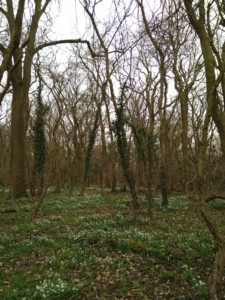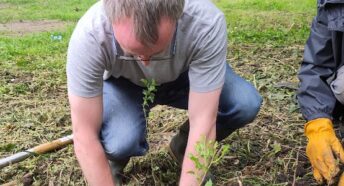In search of snowdrops
Over the next few weeks the snowdrops will start to appear. These beautiful small flowers are one of the first signs that spring is on the way.
Snowdrops look rather delicate but in fact they are well adapted to the cold, with hardened tips to their leaves which help them break through the frozen soil and snow. No wonder that one of their old names was Snow Piercer! Their cells are also full of a natural antifreeze which prevents growth of large ice crystals.
A walk in the woods
Even small areas of woodland can be home to wonderful displays of snowdrops. From small clumps clustered at the bottom of mossy tree trunks to open carpets around bare, architectural trees. The stripped back quality of woodland at this time of year gives a real sense of space which snowdrops help fill with their quiet presence. There are plenty of other things to catch the eye on a woodland snowdrop walk too – the first catkins, fungi on decaying wood, ice patterns in flood water, robins – whose colour seems extra vivid on duller days, squirrels scurrying across high branches, intricate mosses and splashes of lichen.

A little bit of history
It is thought that the first snowdrops may have arrived in England via Italian monks in the fifteenth and sixteenth centuries. Snowdrops are also known as Candlemas Bells because they are in flower at Candlemas (2nd February, 40 days after Christmas) – this is when the church marks the Presentation of Christ in the Temple and the Feast of the Purification of the Blessed Virgin Mary. The white of the flowers was seen as a symbol of purity and so they were often planted around churches. Monastic sites like Fountains Abbey in North Yorkshire, and churchyards remain some of the best places to see drifts of snowdrops.
Snowdrops are mentioned as being present in London gardens in Gerard’s Herbal which was published in 1597. The first ‘wild’ colonies were recorded in Worcestershire and Gloucestershire in the 1770s as the flowers spread from gardens. As Richard Mabey points out in Flora Britannica, snowdrops and people have always been associated with each other. Seemingly isolated roadside colonies often mark the site of a demolished cottage.

Climate change
We’re still having an impact on snowdrops. A long term study at Kew Gardens shows that the snowdrop season begins nearly a month earlier than it did sixty years ago. Warmer winters mean that soon snowdrops may be out at Christmas rather than Candlemas.
Enjoying the seasonal display
- Stick to paths through woodland or in the countryside – this helps keep the displays in good condition and reduces the risk of damage to later spring flowers.
- Snowdrops can be difficult to photograph well, especially on a phone, because cameras struggle to balance the bright white of the flowers with the lower light levels at this time of year. Good tips are to try getting down low or taking a close-up.
- Please don’t pick wildflowers – leave them for everyone to enjoy.
All photographs taken Jan / Feb 2021 in Putnoe Wood, Bedford








